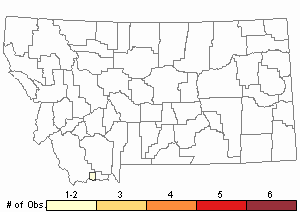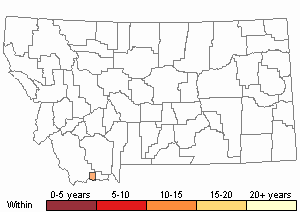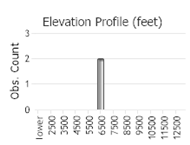View in other NatureServe Network Field Guides
NatureServe
Montana
Utah
Wyoming
Idaho
Wisconsin
British Columbia
South Carolina
Yukon
California
New York
Striated Fingernailclam - Sphaerium striatinum
General Description
Fingernail clams are small "mostly about the size of a finger or thumbnail" bottom-dwelling, filter-feeders found in ponds, lakes and streams throughout Montana. They are native and can be quite abundant, providing food for a variety of animals and producing large accumulations of empty shells. These shells can be quite fragile compared to introduced Asian clams of the family Corbiculidae, which have not been reported in Montana, yet.
Diagnostic Characteristics
"Striae not evenly spaced; surface even except for rest marks and striae; shell inflated; striae not weaker in the region of the beak." (La Rocque 1967). (La Rocque 1967) cites dimensions from various authors and collection sites in the following range: L. 15.5-3.9, H. 12.5-3.1, D. 7.3-2.5 mm (Note: D. not included for largest specimen).
Range Comments
(La Rocque 1967) includes Montana in range, indicates records throughout the United States (in almost every state), some in Canada. (Burch 1972) records the species "throughout the United States and south into Mexico and Central America" and in "Canada from New Brunswick northwest to Great Slave Lake and Upper Yukon River." (Bland and Cooper 1861) indicate the species was collected at the Missouri River above the falls, and at the Hell-Gate River.
Observations in Montana Natural Heritage Program Database
Number of Observations: 2
(Click on the following maps and charts to see full sized version)
Map Help and Descriptions
Relative Density

Recency



 (Observations spanning multiple months or years are excluded from time charts)
(Observations spanning multiple months or years are excluded from time charts)
Habitat
The species is found in a variety of habitats, including small lakes, rivers, creeks, trenches, canals, and sandy shoals. It has not been found in ponds, lagoons, bog ponds, swamps or other stagnant water, one source suggests that these habitats do not have sufficient current to oxygenate the water. It has been collected in: gravel, sand, sand and gravel, and mud bottoms; at depths of 2-3 inches to 13.5 m. (La Rocque 1967). (Clarke 1981) indicates the species is common and occurs "principally in rivers and streams, but also occurs in large lakes and rarely, in small lakes. Does not occur in swamps, stagnant water, or temporary-water habitats."
Food Habits
Fingernail clams are mostly filter-feeders, siphoning in floating particulate organic materials ( small plant or animal) from the water column and straining out the particles and expel the strained water. Pedal feeding from the bottom with the foot muscle has also been observed.
Reproductive Characteristics
"A few unborn young of different sizes are present in most adults." (Clarke 1981).
Stewardship Responsibility
References
- Literature Cited AboveLegend:
 View Online Publication
View Online Publication Bland, T. and J.G. Cooper. 1861. Notice of land and freshwater shells collected by Dr. J.G. Cooper in the Rocky Mountains, etc, in 1860. Annals of the Lyceum of Natural History of New York 7:362-370.
Bland, T. and J.G. Cooper. 1861. Notice of land and freshwater shells collected by Dr. J.G. Cooper in the Rocky Mountains, etc, in 1860. Annals of the Lyceum of Natural History of New York 7:362-370. Burch, J.B. 1972. Freshwater Sphaeriacean clams (Mollusca:Pelecypoda) of North America. EPA Biota of Freshwater Ecosystems Identification Manual No. 3. 31 pp.
Burch, J.B. 1972. Freshwater Sphaeriacean clams (Mollusca:Pelecypoda) of North America. EPA Biota of Freshwater Ecosystems Identification Manual No. 3. 31 pp. Clarke, A.H. 1981. The freshwater molluscs of Canada. National Museum of Natural Sciences, National Museums of Canada, Ottawa. 446 pp.
Clarke, A.H. 1981. The freshwater molluscs of Canada. National Museum of Natural Sciences, National Museums of Canada, Ottawa. 446 pp. La Rocque, A. 1967. Pleistocene Mollusca of Ohio. Department of Natural Resources, Division of Geological Survey Bulletin 62, Part 2. 113-365 + 8 plates.
La Rocque, A. 1967. Pleistocene Mollusca of Ohio. Department of Natural Resources, Division of Geological Survey Bulletin 62, Part 2. 113-365 + 8 plates.
- Web Search Engines for Articles on "Striated Fingernailclam"
- Additional Sources of Information Related to "Mussels / Clams"





